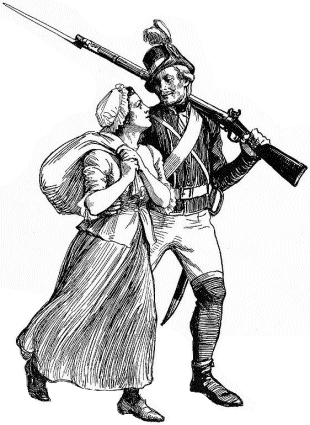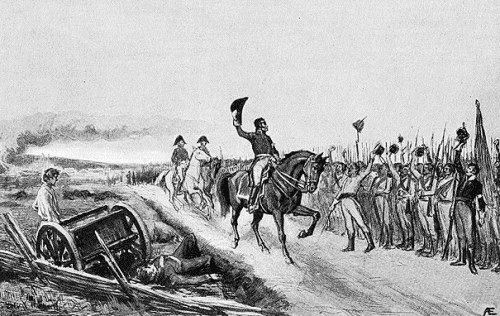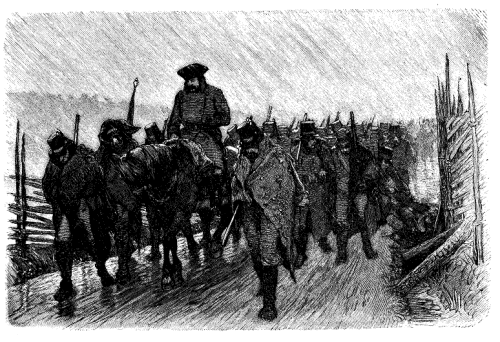Life in the Line of Fire
 Recruitment and civilian life
Recruitment and civilian life
The recruitment methods, the life and tactics of the Russian soldier is described elsewhere on this website (The Russian Army). Here we will only state that while the Russian soldier was very much a serf who experienced blind loyalty and obedience for the Czar and Mother Russia, the Swedish soldier was a free man. He had a strong affection for king and country and was in 1808 more than willing to defend his home and family.
The Regular troops (Värvade) were men who signed on for military service. they were mainly used for garrison troops, such as at Sveaborg. Of about 55.000 troops within the borders of the Swedish kingdom, only 17.000 were Regular, Värvade, troops. However, the bulk of the Swedish army consisted of the "Indelta" troops, which were men who filled the ranks, recruited by the peasants of the kingdom. It was therefore the obligation of the peasants, as a form of tax payment to the Crown, to find soldiers for the military, in the number that such were needed. The peasants took on their duties collectively and were so divided into "Rotar" according to their geographical locations.
The peasants of the different "rotars" then supplied the soldier with a piece of land and a small farm (Soldattorp). This was meant to counter any defections from the ranks as the soldier had his wife and family back home on the farm. It was then the duty of the soldier to work this land and tend to his farm during peacetime. This work was interrupted by the annual regimental meetings where the soldiers gathered and did some training. Often this military training was very lacks in the Swedish army. The soldiers could also be commanded out for work, such as when the fortress of Sveaborg was built and there was required a very large workforce. When the soldier was out on commendations or away in war, the wife and family ran the farm and thereby played a most vital role in the actual warfare.
New army elements during the war of 1808-09 was firstly, the so called Vargering, which meant that reserve battalions were to be produced for every Indelt regiment. Secondly, in 1808 the Landwehr was also introduced in Sweden, here called Lantvärn, but became a sad story of epidemics and organizational crises. In theory the Lantvärn was to be used for garrison units, freeing the regular and indelta regiments for other duties in the field. The Swedish Lantvärn became a disaster.
Tactics of the Swedish army
Due to the terrain situation in Finland, with heavily wooded terrain, bad roads and many lakes and swamps, the military tactics used throughout the war by both sides differed somewhat from those tactics used in the great wars on the continent. The battalion became the standard fightingunit when it came to battle as there just was not enough space for larger units to maneuvre. Skirmishers, and lines of Jaeger units were widely used by both sides. The Russian attackers also tended to use the roads; and as maps were bad and the defenders knew their territory, it would only have been natural for the Swedish to use the cover of the woods to trap and trick the attackers. This did not happen at the higher level though, and the Russian military showed much more tactical - and strategic - innovation than the Swedish. The Russians often came marching over frozen lakes and rivers, making these into improvized road systems. The Swedish army and the commanders only tended to adapt to the Russian techniques

As a rule a Swedish battalion consisted of four companies (divided into eight platoons) and in battle these were deployed in line formation with two ranks depth, but during the marching, the army moved in column formation. If the number of the battalion was reduced to below 80 men, it was a rule to form three companies and six platoons instead of the original. In line, the front could be up to 170 metres long.
All according to the regulations of 1806, which were still in use during the war, the infantry soldiers should stand on two lines. The space between the men in line was one inch. The men were in each line ordered according to their length from the flanks in to the middle. the lines were therefore very tight when the enemy was engaged. In wooded terrain, though "Swarm" (Swe. Svärm) formation could be used. The following is an excerpt from Swedish additions to the regulations of the year 1807. "Commanded: Gif Akt att Attaquera! 84. The Musket is thrown into the left hand, which takes it by the barrell, so it can be used to parry with. If a redoubt or other fortification is to be attacked, the musket is carried on the back and the sword instead drawn. Svärma! Repeated by the unit commanders. (Source: Kungliga Österbottens regemente, C-B. J. Petander)" Every battalion had two Jäger platoons (1 officer, 2 underofficers, 2 corporals and 48 men), formed of the "fastest and most vigilant men, and rather such who had been hunting before", these were deployed on the flanks but could also be used to form a skirmisher line in front of the entire battalion. Every battalion carried two banners (in line formation these were in the middle), defended by a special Banner platoon.
When the battalion stood in line formation, the firing was handled on wing, company, platoon or line level. When two salvos were to be fired, the first one was fired by both lines on 120 paces distance from the enemy, the other one was fired on 60 paces distance by the second line, to save the salvo of the first line. Then the bayonets were lowered and "Gå på Marsch!" (Forward March!) was ordered. The last salvo was fired on 8-10 paces from the enemy, just before the collission.

The bayonet charge is one of the most famous activities of war on the Napoleonic era battlefield, and while it in the war of 1808-09 surely did occur many horrifying melees and charges, the impact on the morale for those attacked was much more important. Many times, the defenders would just turn their tail and run the other way in the sight of shining bayonets and screaming angry enemy troops coming at them. A successful bayonet charge, therefore depended on how effective the musket salvo before the charge had been. The good old bayonet charge was still very much a specific Swedish military tradition. The old warrior king Karl XII and his Karoliner soldiers always relied on this form of brutal attack when winning their most important and famous victories. In the Swedish army those traditions from the kingdom's glorious past were admired.
The real battles were fought on open fields, where the obstacles were at a minimum so the massive firepower of the collected line formation could be used to full effect. And even although this, the fire often did little effect as accuracy was bad and the rate of fire was at most just under one minute for reloading. It therefore became necessary for the commanders to try to force the enemy into such battlegrounds that were at the enemy's disadvantage, and there beat him. These old-fashioned tactics came from the fact that most of the officers in the army were of the old school, where the linear tactics a' la Friedrich the Great were still admired. The ways of using the column- and skirmisher techniques were still very new to the Swedish army.
In battle, the victory often came to him who could outflank his enemy; binding the enemy with frontal fire, while sending troops to penetrate the enemy lines. the use of cavalry in this war was not very widespread. At most the invading Russians had 11% of their army made up of cavalry and the Swedish numbers were much lower than that. Reconnaissance and intelligence was often lacks; and entire battles could therefore be fought in the "Fog of War". At the Swedish infantry units all officers above the rank of Major were mounted.
The real danger in the military in those days, lay not in the dangers met on the field of battle, but in the everyday life of being a soldier. And this often consisted mostly of endless marching on bad roads, camping, standing in line for hours on end, waiting, finding shelter for the night and the troubles of filling ones belly. Diseases and illnesses were raging among the soldiers and many more soldiers perished in these than in regular fighting. As an example, a typical battalion could take part in battle, skirmish and fighting for six days on a campaign of eight months; the rest of the time was spent replenishing and regaining strength (the example is from När riket Sprängdes by Eirik Hornborg).
The highest military command was entrusted upon the king himself. King Gustav IV Adolf had a gifted chief of staff in Wilhelm afThibell, who constantly came with suggestions and ideas on how to fight the war more efficiently. He was most often rejected by the king, who had his own destructive ideas. The highest command was seriously weakened by the king, who overestimated the strength of Sweden's forces and resources. The commander of the army in Finland was Wilhelm Mauritz Klingspor, an older gentleman, cautious to the extreme. From October 1808, the army was commanded by the elderly Nathanael af Klercker. The honour of fighting the war, although the weak higher command, therefore fell upon the commanders in the field; like Adlercreutz, who commanded the main army, von Döbeln with his Björneborg regiment and Sandels who fought successfully with his Savolax Brigade in the east.

Back to The art of War
© Göran Frilund 2000-03, All Rights Reserved.
If you've surfed onto this page from outside and there is no menu on the left,
CLICK HERE for the full Website.

 Recruitment and civilian life
Recruitment and civilian life

